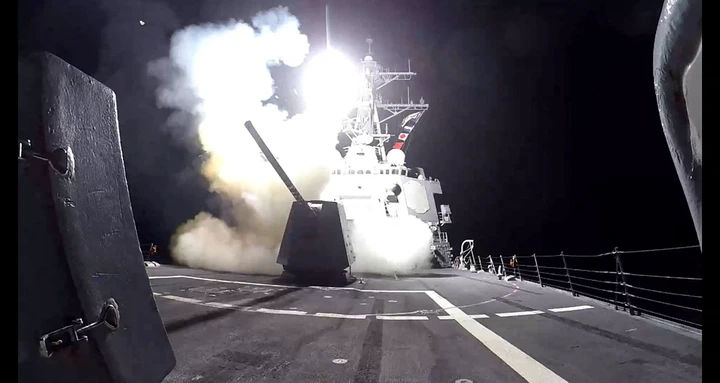The video shows missiles being launched from USS Gravely and USS Carney blasting targets that posed an “imminent threat” to American ships in the Red Sea....CLICK HERE TO CONTINUE READING.>>
Missiles were launched from USS Gravely and USS Carney
Footage shows explosions in Yemen during Saturday’s attacks
A US F/A-18 fighter jet can also be seen taking off from the USS Dwight D Eisenhower aircraft carrier.
The US Central Command said on Sunday they had carried out another strike “in self-defence.”
It said the strikes were against a Houthi land attack cruise missile and four anti-ship cruise missiles which were “prepared to launch” against ships in the Red Sea.
A statement read: “US forces identified the missiles in Houthi-controlled areas of Yemen and determined they presented an imminent threat to US navy ships and merchant vessels in the region.
“These actions will protect freedom of navigation and make international waters safer and more secure for US Navy vessels and merchant vessels.”
British forces joined the US to strike Yemen’s Houthis on Saturday amid boiling tensions – just hours after Iraq warned that the Middle East was “on the brink of the abyss.”
The Pentagon confirmed the attack struck 36 targets in Yemen.
Laser-guided Tomahawk missiles and Paveway bombs, 1,200mph fighter jets, Reaper drones and destroyers were used alongside the RAF planes.
The strikes hit 36 Houthi targets in 13 locations, American officials said, in the third wave of attacks in the past two weeks, striking Houthi weapon launchers, radar sites, drones and buried weapons facilities.
The Ministry of Defence said the Typhoons used Paveway IV precision-guided bombs against multiple military targets “identified by careful intelligence analysis at three locations”.
The strikes came in retaliation to almost daily missile or drone attacks against commercial and military ships in the Red Sea and Gulf of Aden.
They followed America’s strikes in Iraq and Syria on Friday which also targeted Iran-backed militant groups.
The US has refused to rule out direct strikes on Iran with White House National Security Adviser Jake Sullivan saying the weekend attacks are “not the end” of US action in the region.
Asked if the US had taken Iran strikes “off the table”, he said the president is “determined to respond forcefully to attacks on our people”.
Sullivan explained: “What happened on Friday was the beginning, not the end, of our response, and there will be more steps – some seen, some perhaps unseen.”
Meanwhile, a Yemeni official has issued a fresh threat if strikes continue – this time against Italy.
Mohamed Ali al-Houthi, head of the Houthi’s supreme revolutionary committee, told the daily La Repubblica that Italy must be neutral in the Israeli-Palestinian conflict and put pressure on Israel to stop attacks on Gaza, adding that would be the only way to achieve peace in the region.
Italy said on Friday it would provide the admiral in command of a European Union Red Sea naval mission it has joined to protect ships from attacks by Yemen’s Houthi militia.
The mandate of the mission, which will be launched in mid-February, will be to protect commercial ships and intercept attacks, but not take part in strikes against the Houthis, the EU’s foreign policy chief Josep Borrell has said.
Who are the Houthis?
THE Houthi rebels are terrorising vessels and warships in the Red Sea – but who are they?
The Shia militant group, which now controls most of Yemen, spent over a decade being largely ignored by the world.
However, since the outbreak of the Israel-Gaza war they sprung from relative obscurity to holding roughly £1trillion of world trade hostage – turning one of the world’s busiest shipping lanes into an active warzone.
Their warped slogan is “Death to America, Death to Israel, curse the Jews and victory to Islam”.
Why are they attacking ships?
The rebel group has been launching relentless drone and missile attacks on any ships – including warships – they deem to be connected with Israel in solidarity with their ally Hamas.
The sea assaults have threatened to ignite a full-blown war in the Middle East as ripples from Israel’s war in Gaza are felt across the region – with Iran suspected of stoking the chaos.
However, there have been frequent attacks on commercial vessels with little or no link to Israel – forcing global sea traffic to halt operations in the region and sending shipping prices soaring.
Houthi attacks in the Red Sea increased 50 per cent between November and December.
The rebel group’s leaders have previously pledged the attacks will continue until Israel stops its devastating offensive inside Gaza – despite recent US and UK strikes on their military strongholds.











